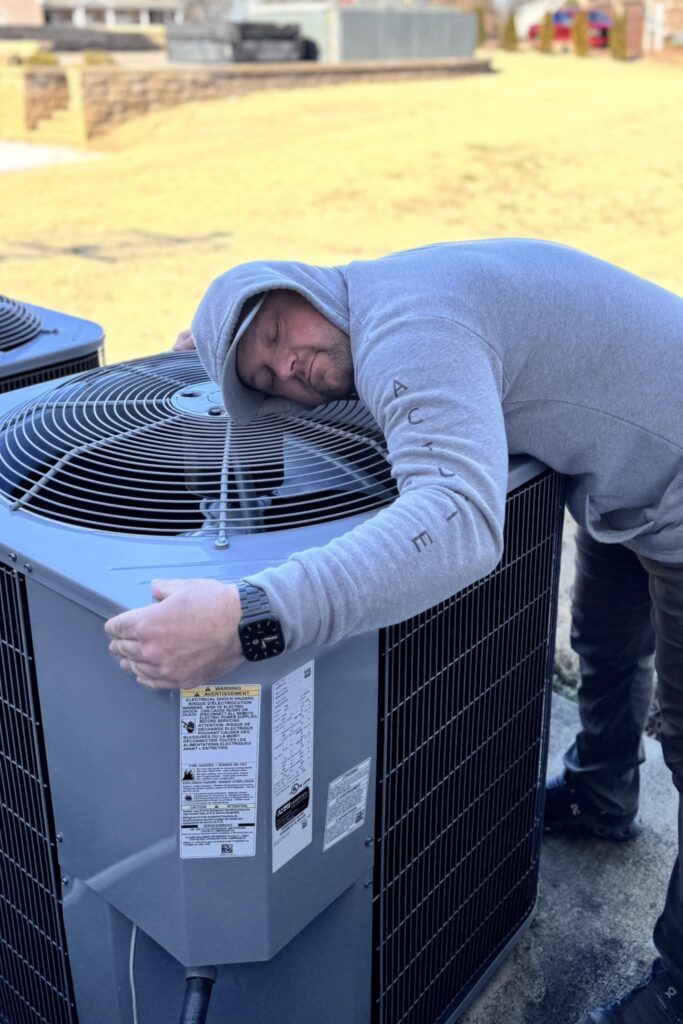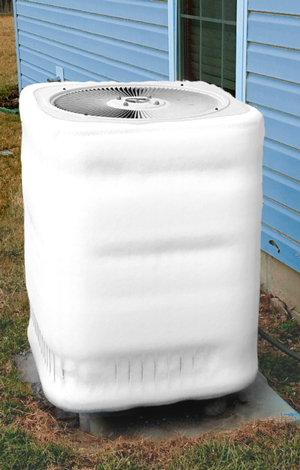 Just because it’s cold outside doesn’t mean you should switch your heat pump to emergency heat. Here’s why that’s a costly mistake.
Just because it’s cold outside doesn’t mean you should switch your heat pump to emergency heat. Here’s why that’s a costly mistake.
What “Emergency Heat” Actually Means
If you own a home with an electric heat pump, you’ve probably noticed a setting on your thermostat labeled “EM HEAT” or “Emergency Heat.” Most people think that when temperatures drop below freezing, you’re supposed to flip that switch. After all, it’s cold, right? Shouldn’t you help your system out? Give it a little boost?
Nope. That’s one of the most common HVAC myths still floating around.
Your heat pump already knows what to do. In normal heating mode (heat pump), it “pulls” warmth from the outside air and moves it indoors. Even when it’s cold outside, there’s still plenty of heat energy in that air. When the outdoor temperature drops to the point that your heat pump can’t keep up, your system will automatically engage its auxiliary heat (electric resistance strips) to help out.
When you manually flip to emergency heat, you’re actually disabling the heat pump entirely. You’re telling it, “don’t even try, just run the backup heat full-time.” That backup heat costs about two to three times more to operate than the heat pump. So unless your system is broken or literally encased in ice, you’re just wasting money.
The Real Purpose of Emergency Heat
HVAC School, one of the most reputable educational sources in the industry, says it best: Emergency heat is for emergencies. Period.
That means your outdoor unit has failed, it’s iced over, or you’ve lost refrigerant. In those cases, you flip to EM HEAT so your house doesn’t turn into an icebox while waiting for service. But it’s not a “cold weather” setting.
The site also breaks down how a heat pump’s coefficient of performance (COP), basically its efficiency rating, remains well above 1 in many modern systems even in freezing temperatures. That means for every dollar of electricity your system uses, you’re still getting more than a dollar’s worth of heat output. The emergency setting, on the other hand, has a COP of 1 or less. Every dollar of electricity you put in gives you one dollar of heat back and that’s it.
In other words, your system is more efficient when you let it do its job.
There’s Still Heat in “Cold” Air
One of the coolest facts about thermodynamics is that there’s technically still heat in the air until you reach absolute zero, which is minus 459.67°F. HVAC School points this out in one of their podcasts: “There’s no such thing as cold air. It’s just air with less heat energy.”
Modern heat pumps are designed to pull that remaining energy out even when it feels brutally cold to us. That’s why newer systems, especially those built in the last 15 to 20 years, can comfortably heat homes in outdoor temperatures well below freezing.
So if it’s 20°F outside and your heat pump is running a lot, that’s normal. It’s doing its job efficiently. Switching to emergency heat at that point isn’t helping. It’s like trading in a hybrid car for a monster truck because traffic got bad.
The Myth of the Freezing Point Rule (and Why Your Heat Pump Still Works in the Single Digits)
Here’s where people really underestimate modern heat pumps. HVAC School explains this clearly in their “Good COP, Bad COP” lesson. The efficiency of a heat pump, called the coefficie
nt of performance (COP), doesn’t suddenly crash just because it’s cold. Even when outdoor temperatures drop into the teens or single digits, many systems can still deliver two or more units of heat energy for every one unit of electricity used.
That’s right. Even at 10°F outside, your heat pump can still outperform electric resistance heat, meaning it’s still cheaper to let it run normally than to flip over to emergency heat.
Despite this, the old “freezing point rule” still lingers. For decades, homeowners have been told to flip the thermostat to EM HEAT once temperatures drop to 32°F. You’ve probably heard someone say, “That’s what my dad always did.”
That advice made a little more sense 30 years ago when older heat pumps really did struggle in the cold. But today’s systems are built with better compressors, refrigerants, and defrost controls. Unless you have an antique unit from the 1980s, that rule no longer applies.
If your system is properly maintained, it will automatically manage when to use auxiliary heat without your help. So when someone says, “It’s in the twenties tonight, you should go ahead and switch it over,” that’s bad advice. The numbers prove otherwise. Unless your outdoor unit is frozen solid or broken, leave it alone. Let it run, and let it save you money.
Stop the Blanket Advice: Educate, Don’t Panic
Here’s where a lot of so-called “professionals” get it wrong. They love to toss out the same tired advice, “better safe than sorry,” and tell everyone to switch to emergency heat once it gets cold outside. That’s not being safe, that’s just being lazy.
If you’re in the business of helping people, your job is to educate them. Send out emails. Text your clients. Make posts that explain how their systems work. When you’re on a service call, take a few minutes to tell the homeowner what kind of system they have and when, if ever, it makes sense to switch to emergency heat.
That’s how you keep people safe. Not by telling them to flip a switch out of fear, but by teaching them how to use their equipment properly.
And for anyone clinging to “my dad always said” logic, I don’t care what your dad told you about switching to emergency heat when it gets cold. This isn’t about opinions. It’s about physics, thermodynamics, and all those fancy words I like to say to make me sound smart. The real professionals who literally teach this stuff for a living agree: emergency heat is for emergencies. Period.
What About Dual-Fuel Systems?
In some parts of the country, homeowners have dual-fuel systems, a combination of a heat pump and a gas furnace. In those setups, the thermostat automatically switches from the heat p
ump to gas heat at a certain temperature called the thermal balance point.
HVAC School describes that balance point as the temperature where the heat pump’s output matches the home’s heat loss. Below that, the system may rely on the furnace because it’s more cost-effective.
That’s an entirely different setup. This article focuses on the typical electric-only heat pumps, which are most common in the area I service. If you have gas backup, your system already knows when to switch, and you don’t need to intervene manually.
When It Might Make Sense to Use Emergency Heat
There are legitimate reasons to flip that switch, but they’re rare. Here’s when it’s justified:
- Your outdoor unit has failed or frozen solid. A fallen branch, heavy ice buildup, or motor failure can stop it from running.
- You’ve lost refrigerant. A leak means the system can’t move heat effectively.
- A major power or control failure. If the outdoor portion won’t energize but the indoor blower still works, EM HEAT can keep your home livable until repairs are made.

Heat pump look like this? Time to switch to EM Heat and call for repair.
Those are true emergencies. In each of these cases, the system isn’t functioning properly, so you’re not bypassing efficiency. You’re just staying warm until a professional can fix it.
Possible exception during severe ice storms: Some argue that in an ice storm or freezing rain, ice can build up on the fan blades and potentially break loose when the unit cycles on, damaging the coil. While it’s possible, this is rare and generally only a concern if the unit has been idle long enough to freeze. In most cases, a heat pump that’s actively running stays warm enough to prevent dangerous ice buildup. It’s another example of why “better safe than sorry” isn’t a universal rule, it’s about understanding how your system actually works.
Efficiency and Cost Comparison
Let’s put some numbers behind the logic.
According to the U.S. Department of Energy, a standard heat pump delivers 2.0 to 3.0 units of heat for every 1 unit of electricity consumed under typical conditions. That’s a COP of 2 to 3.
Electric resistance, or emergency heat, as noted by Precision Comfort Systems, provides exactly 1 unit of heat per 1 unit of power, a COP of 1. That means your operating costs double or triple the moment you switch to EM HEAT.
Natural gas systems can be cheaper to operate depending on local rates, but with all-electric systems, sticking with the heat pump is almost always the winner. Even if it runs longer cycles, it’s using less energy per minute.
So when someone tells you, “Your system’s been running a long time, you should switch to emergency heat,” they’re unknowingly suggesting you triple your power bill.
When Your Heat Pump Runs Constantly
It’s normal for a heat pump to run longer when it’s cold. Unlike a gas furnace that blasts hot air in short bursts, heat pumps provide steady, lower-temperature heat. They’re designed for continuous operation during cold weather.
If your home isn’t maintaining temperature or you see frost building up on the outdoor coil that doesn’t clear after a few minutes, then it’s time for maintenance, not a manual switch to EM HEAT. A dirty coil, low refrigerant, or bad defrost sensor could all mimic “cold weather problems.”
That’s when you call a qualified HVAC technician, not flip the switch.
Best Practices for Homeowners
- Leave your thermostat in “Heat” mode. Let the system decide when to use auxiliary heat.
- Don’t block or cover your outdoor unit. Clear away snow and debris to maintain airflow.
- Keep filters clean and schedule regular maintenance. A clogged filter reduces efficiency.
- Avoid large thermostat adjustments. Cranking it up 10 degrees just forces the system into auxiliary mode unnecessarily.
- Understand your system. If you’re unsure whether you have electric-only or dual-fuel, ask your HVAC tech during your next service visit.
Following these steps keeps your system efficient and your energy bills reasonable.
The Bottom Line
Emergency heat is not a “cold weather setting.” It’s a safety net for when something goes wrong. As HVAC School puts it, “Emergency heat is for emergencies.”
So when temperatures dip below freezing, resist the urge to flip the switch. Your heat pump was built for this. Let it work. You’ll stay comfortable, save money, and put less strain on the power grid in the process.
If you ever find yourself wondering whether your system is actually struggling or just doing its job, schedule a quick check-up. A consultation with a good HVAC technician can tell you more than a hunch, and it will cost a lot less than a month of running emergency heat.
